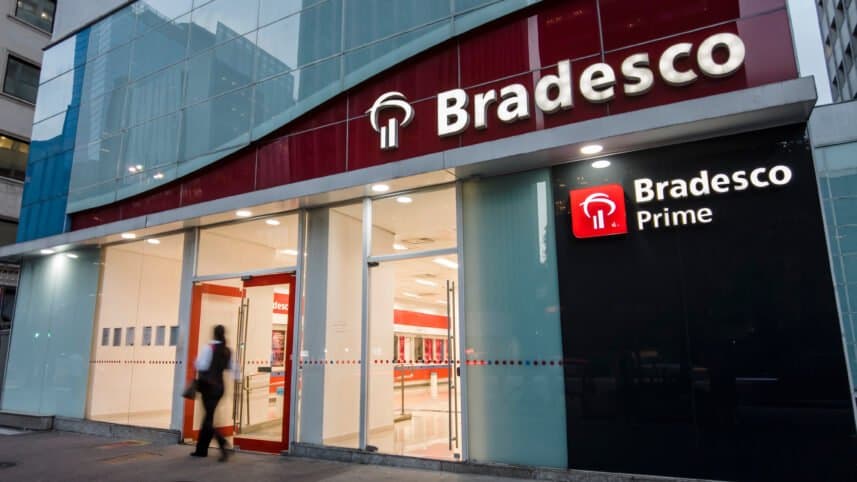Banco Bradesco’s Q1 2025 Earnings: Unlocking Growth Amid Challenges
Explore Banco Bradesco’s Q1 2025 earnings revealing strong net income growth, robust loan expansion, and digital innovation, while navigating deposit outflows and economic headwinds in Brazil’s banking sector.

Key Takeaways
- Bradesco’s recurring net income surged 39% year-over-year in Q1 2025.
- Loan portfolio expanded 12.9%, outpacing full-year growth targets.
- Return on average equity improved to 14.4%, beating sector averages.
- Digital innovation cut service times and boosted operational efficiency.
- Deposit outflows remain a challenge amid Brazil’s high interest rates.

Banco Bradesco’s Q1 2025 earnings report reads like a financial thriller with a plot twist. The Brazilian banking giant posted a recurring net income of R$5.86 billion, a striking 39% jump from last year, fueled by robust loan growth and disciplined cost control. With a loan portfolio swelling to over R$1 trillion and a return on average equity (ROAE) climbing to 14.4%, Bradesco is flexing its muscle in a volatile economy. Yet, beneath the surface, challenges like a 26% drop in demand deposits and pressure on funding costs remind us that the road to recovery isn’t without bumps. This article unpacks Bradesco’s financial performance, technological strides, and strategic moves, offering a fresh lens on how a legacy bank navigates Brazil’s shifting economic tides.
Driving Income Growth
Bradesco’s Q1 2025 recurring net income of R$5.86 billion didn’t just meet expectations—it soared 39% year-over-year, signaling a powerful comeback. CEO Marcelo Noronha credits revenue growth as the main engine behind this surge, with net interest income climbing 15.5% to R$17.2 billion. Imagine the bank as a savvy shopkeeper who not only sells more but also charges smarter prices, reflected in a net spread of 3.0% after provisions. Fee and commission income also played a starring role, rising 10.2% thanks to booming card transactions and capital markets advisory. This mix of interest and fees is like a diversified playlist—keeping the bank’s tune fresh and profitable.
Yet, this growth story isn’t just about numbers. Noronha’s selective credit approach, focusing on collateral-backed loans, reflects a cautious optimism. The bank’s risk appetite was adjusted late last year, ensuring that while the loan book expands, quality doesn’t slip. This balance is crucial in Brazil’s volatile economy, where a misstep could turn profits into pitfalls. Bradesco’s ability to grow income while managing risk challenges the myth that banks must choose between growth and safety.
Expanding Loan Portfolios
Bradesco’s loan portfolio swelled to R$1.03 trillion in Q1 2025, a 12.9% jump year-over-year that outpaces its full-year target of 4% to 8%. This growth is no accident—it’s a strategic push into retail and small business lending. Retail loans, including personal, payroll-deducted, and rural credit, grew 16.2%, while micro, small, and medium-sized enterprises (MSMEs) lending surged nearly 30%. Picture a gardener planting seeds in fertile soil: Bradesco is nurturing segments with strong demand and growth potential.
The acquisition of 50% of Banco John Deere added R$17.3 billion to the portfolio, further fueling expansion. Importantly, the share of collateralized loans rose to 57%, underscoring the bank’s commitment to quality. This counters the common fear that rapid loan growth means reckless lending. Instead, Bradesco’s approach blends ambition with prudence, ensuring that its loan book is both large and resilient. The stable delinquency rates, with individual loans delinquency dropping to 5.1%, reinforce this narrative of controlled growth.
Enhancing Operational Efficiency
Behind Bradesco’s profit surge lies a story of leaner operations and smarter tech. Operating expenses fell 9% quarter-over-quarter to R$15.01 billion, pushing the efficiency ratio down to 49.7%. This means the bank spends less than 50 cents to earn a real Brazilian real—a feat in a sector often criticized for bloated costs. The closure of 1,392 branches since Q1 2024 reflects a bold move away from traditional banking footprints toward digital-first strategies.
Technology is the secret sauce here. Bradesco now handles 100% of initial client interactions through AI, slashing service times by 10% and boosting call center capacity by 50%. Internal tools like Corporate BIA and GitHub Copilot have cut coding time by over a third, accelerating project delivery. This isn’t just efficiency for efficiency’s sake; it’s about transforming customer experience and operational agility. The myth that banks are slow-moving giants falls flat when a legacy institution like Bradesco embraces AI to outpace digital rivals.
Navigating Deposit Challenges
Despite the upbeat earnings, Bradesco faces a thorny challenge: a 26% plunge in demand deposits quarter-over-quarter. This shift reflects clients moving funds into higher-yield products amid Brazil’s steep 14.75% benchmark interest rate. For the bank, this means funding costs are under pressure, squeezing margins even as loans grow. It’s like a restaurant seeing diners order pricier dishes but paying with smaller tips—good for revenue, tricky for cash flow.
This deposit drain underscores a broader challenge in Brazil’s banking landscape: balancing growth with stable funding. While Bradesco’s Tier 1 capital ratio rose to 11.1%, profitability still lags pre-crisis levels. Analysts caution that reversing deposit outflows and diversifying revenue beyond interest income are critical for sustained recovery. The bank’s renewed share buyback program signals confidence but also raises questions about capital allocation amid these headwinds. Bradesco’s journey reminds us that even strong earnings can mask underlying vulnerabilities.
Driving Digital Transformation
Bradesco’s embrace of digital innovation is more than a tech upgrade—it’s a strategic lifeline. With AI handling all initial client interactions, the bank has cut service times by 10% and boosted call center capacity by half, turning customer frustration into satisfaction. Internally, tools like Corporate BIA and GitHub Copilot have slashed coding and project lead times by over 30%, turbocharging productivity.
This digital pivot challenges the myth that traditional banks can’t compete with nimble fintechs. By closing nearly 1,400 branches, Bradesco is shedding legacy costs and focusing on scalable, tech-driven growth. The bank’s push into digital retail credit via the Bradesco Principal platform and expansion of SME banking with 150 new corporate branches show a hybrid approach—melding human touch with digital speed. In a market where speed and convenience win hearts, Bradesco’s tech investments are a beacon of how legacy banks can reinvent themselves without losing their soul.
Long Story Short
Banco Bradesco’s Q1 2025 results paint a picture of resilience and reinvention. The bank’s impressive income growth and loan expansion underscore a successful blend of strategic focus and operational discipline. Digital transformation efforts, such as AI-driven client interactions and streamlined coding processes, are not just buzzwords but tangible drivers of efficiency and customer experience. However, the steep decline in demand deposits signals a cautionary tale about shifting client behaviors and funding pressures. For investors and observers, the key takeaway is that Bradesco’s journey is far from over. Sustained success hinges on balancing growth with risk, diversifying revenue streams, and continuing to innovate in a challenging economic landscape. The relief of a funded emergency account feels good—Bradesco’s challenge is to keep that relief steady amid Brazil’s financial storms.